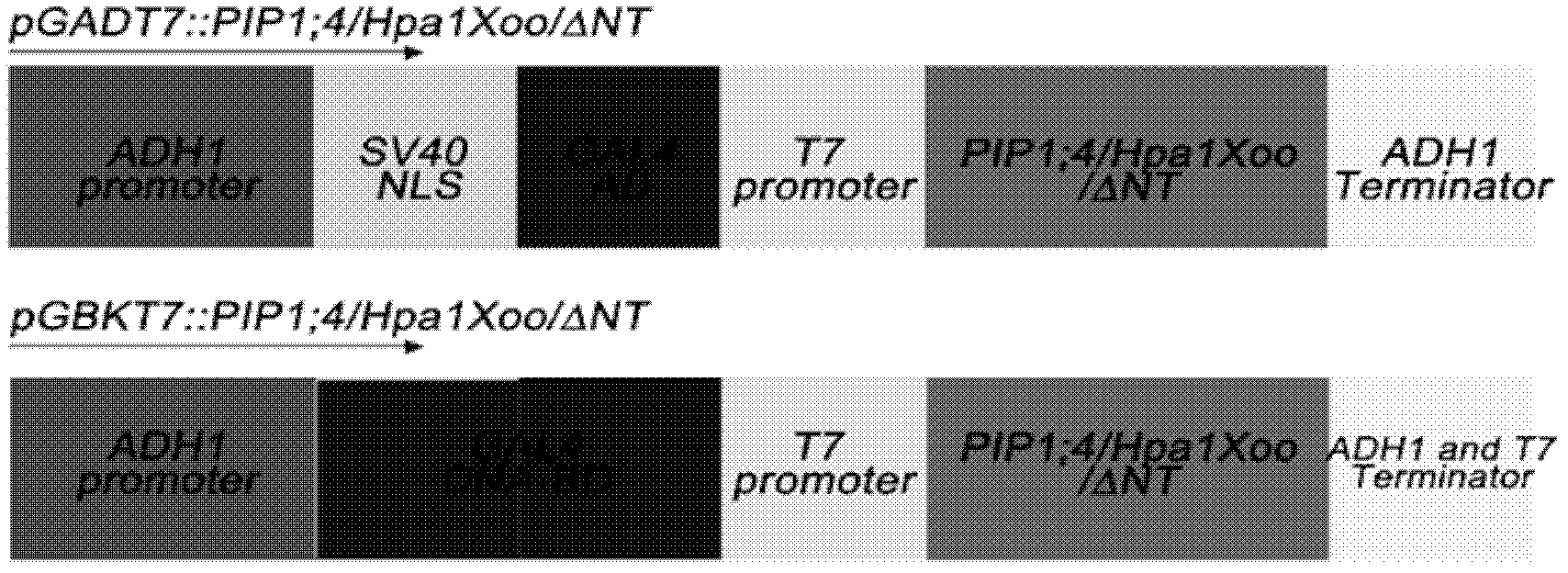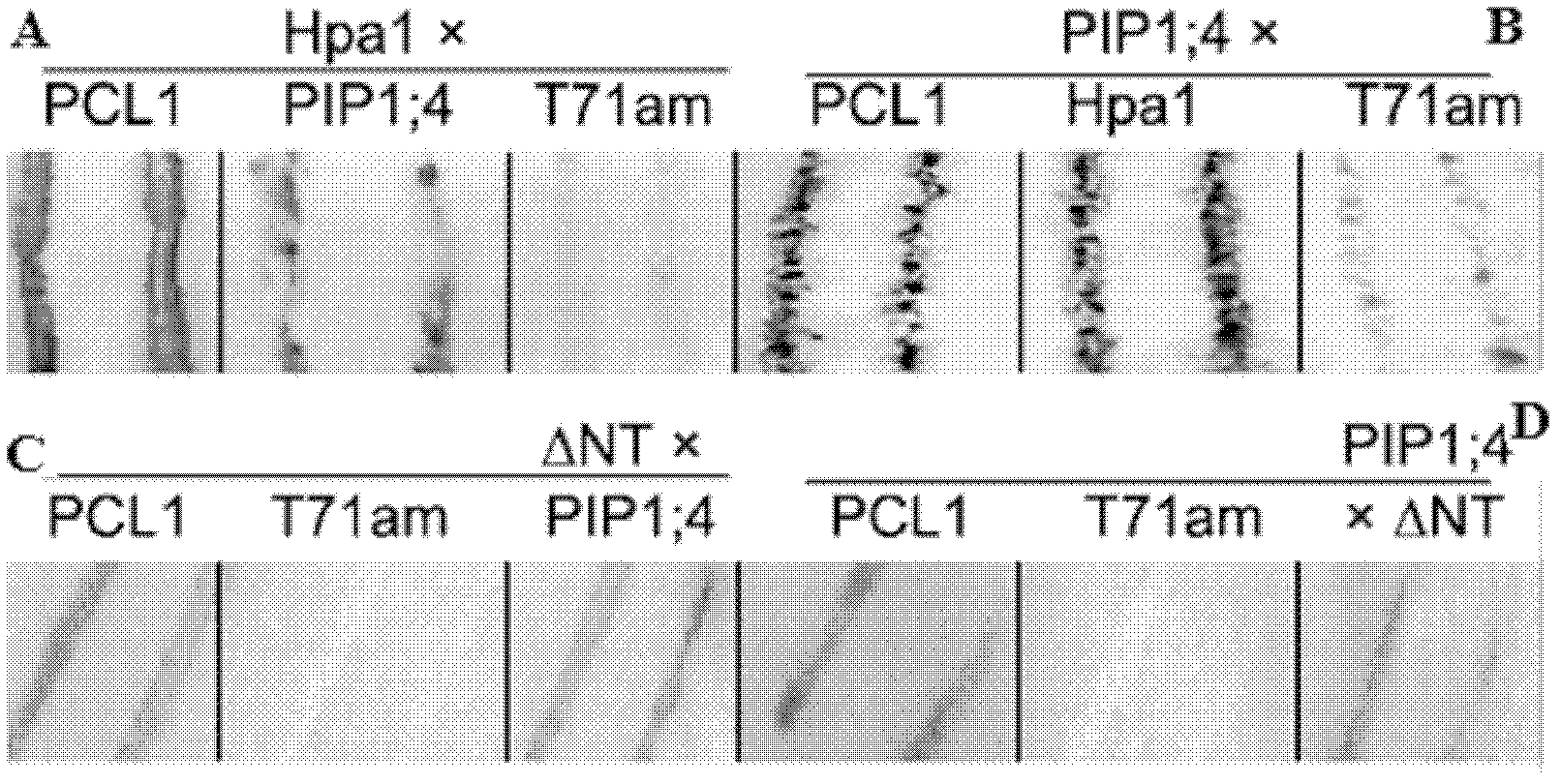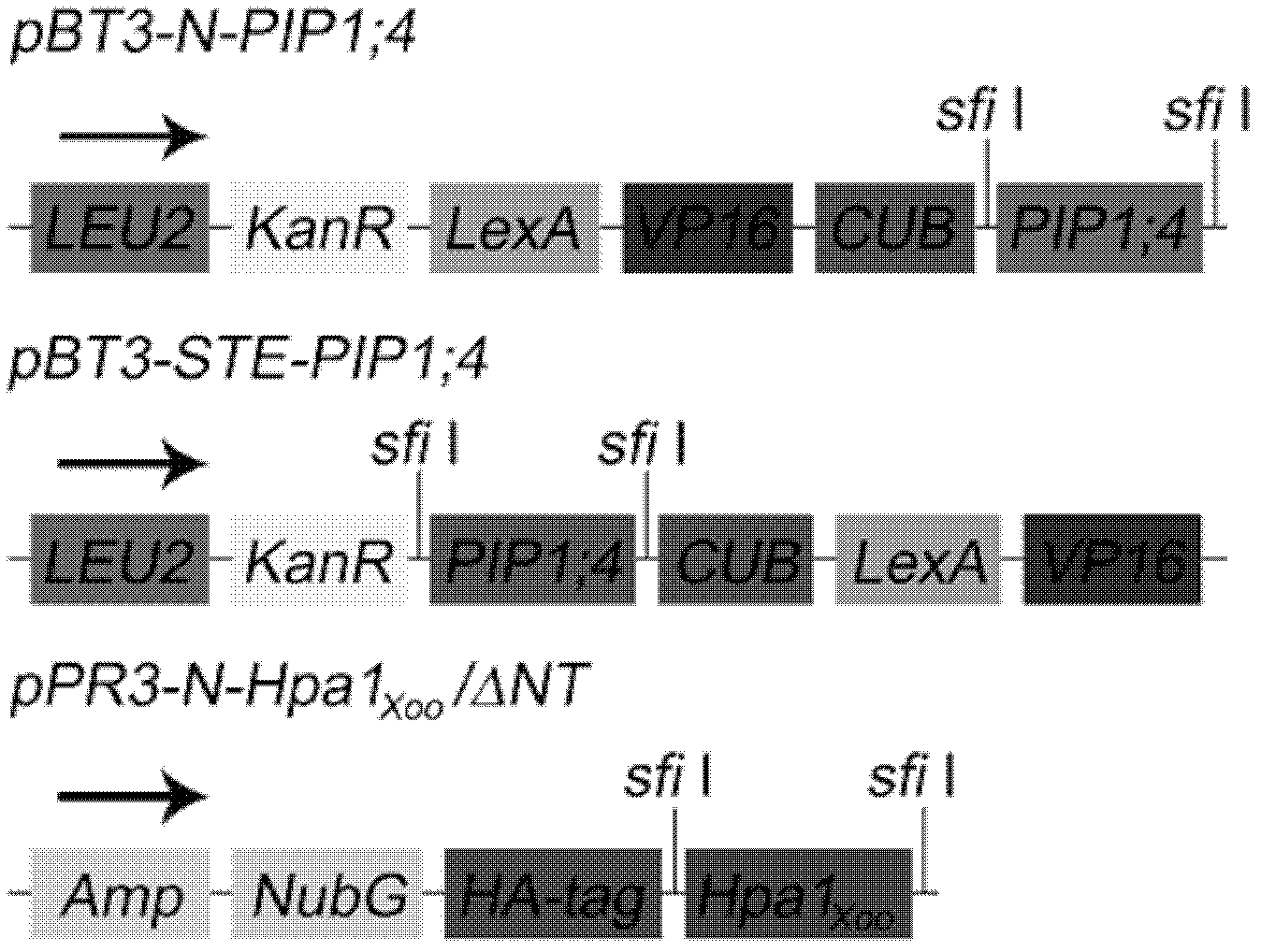Application of aquaporin gene in construction of interaction carrier capable of interacting with Hpa1Xoo
An aquaporin and carrier technology, applied in the biological field, can solve the problem that the reporter gene cannot be activated
- Summary
- Abstract
- Description
- Claims
- Application Information
AI Technical Summary
Problems solved by technology
Method used
Image
Examples
Embodiment 1
[0043] Example 1 Yeast two-hybrid system vector construction
[0044]Using ExTaq enzyme (purchased from takara) to amplify Hpa1 by PCR method from genomic DNA of rice bacterial leaf spot Xoo and its Hpa1Xoo protein N-terminal 53 amino acid deletion sequence - ΔNT, from Arabidopsis ecotype Col-0 (seed in http: / / www.arabidopsis.org - purchase, grow to two leaves) amplify PIP1 in genomic DNA; 4 (SEQ ID No.1), amplification primer is shown in Table 1, and amplification condition is as follows: Hpa1 Xoo : 95°C, 5min; 95°C, 30sec, 55°C, 45sec, 72°C, 1.5min, 30cycles; 72°C, 10min; ΔNT: 95°C, 5min; 95°C, 30sec, 55°C, 45sec, 72°C, 1min , 30cycles; 72°C, 10min; PIP1; 4: 95°C, 5min; 95°C, 1min, 57°C, 45sec, 72°C, 2min, 30cycles; 72°C, 10min.
[0045] Using the method of TA cloning, the Hpa1 Xoo , ΔNT and PIP1; 4 were cloned into pMD19-T simple vector (purchased by takara company), selected positive clones, sent samples for sequencing and saved positive clones, after the sequencing wa...
Embodiment 2
[0049] Example 2 Verification of yeast two-hybrid system
[0050] Extract pCL1, pGADT7-T, pGBKT7-53, pGBKT7-Lam (purchased by Clontech Laboratories, Inc.), pGADT7::PIP1; 4, pGBKT7::Hpa1 Xoo , pGBKT7::ΔNT, pGADT7::Hpa1 Xoo , pGADT7::ΔNT and pGBKT7::PIP1;4 plasmids.
[0051] The specific method is verified according to the method on Clontech Laboratories, Inc. Yeast Protocols Handbook FOR RESEARCH USE ONLY PT3024-1. The strain used is yeast Y190 (Clontech Laboratories, Inc. Yeast Protocols Handbook FOR RESEARCH USE ONLY PT3 024-1).
[0052] Spread a common sterilized filter paper in a Petri dish, add 2.5-5.0ml Z buffer / X-gal solution (see Yeast Protocols Handbook) to wet the filter paper; then put chromogenic filter paper (Whatman 5# filter paper or Grade 410 filter paper) cut into a rectangle, put it in a petri dish, add a small amount of sterilized water to moisten it, pick up the colony with a toothpick and gently draw a line on the filter paper, freeze it directly in liqu...
Embodiment 3
[0053] Example 3 Membrane yeast two-hybrid system PIP1; 4 and Hpa1 Xoo Vector construction
[0054] Use pGADT7::PIP1 obtained in Example 1; 4, pGBKT7::Hpa1 Xoo , pGBKT7::ΔNT as a template, using the primers in Table 2, wherein PIP1; 4 genes were amplified using 1PIP1; 4 and 2PIP1; 4 primer pairs respectively, and the amplification conditions were: 95°C, 5min; 95°C, 50sec, 61 ℃, 45sec, 72℃, 1min, 30cycles; 72℃, 10min, the amplified product was cloned into pMD19-T simple vector (takara company) by TA cloning, positive clones were selected, sent for sequencing and saved positive clones for sequencing After being correct, extract the plasmid of the positive clone, digest it with Sfi I (takara company), and cut the gel to recover the target fragment; connect the above-mentioned cloning products obtained by using 1PIP1; 4, 2PIP1; 4 amplification to pBT3-N, pBT3-STE respectively Plasmids (Dualsystems Biotech) obtained pBT3-N::PIP1; 4, pBT3-STE::PIP1; 4 (eg image 3 ); Hpa1 Xoo An...
PUM
 Login to View More
Login to View More Abstract
Description
Claims
Application Information
 Login to View More
Login to View More - R&D Engineer
- R&D Manager
- IP Professional
- Industry Leading Data Capabilities
- Powerful AI technology
- Patent DNA Extraction
Browse by: Latest US Patents, China's latest patents, Technical Efficacy Thesaurus, Application Domain, Technology Topic, Popular Technical Reports.
© 2024 PatSnap. All rights reserved.Legal|Privacy policy|Modern Slavery Act Transparency Statement|Sitemap|About US| Contact US: help@patsnap.com










